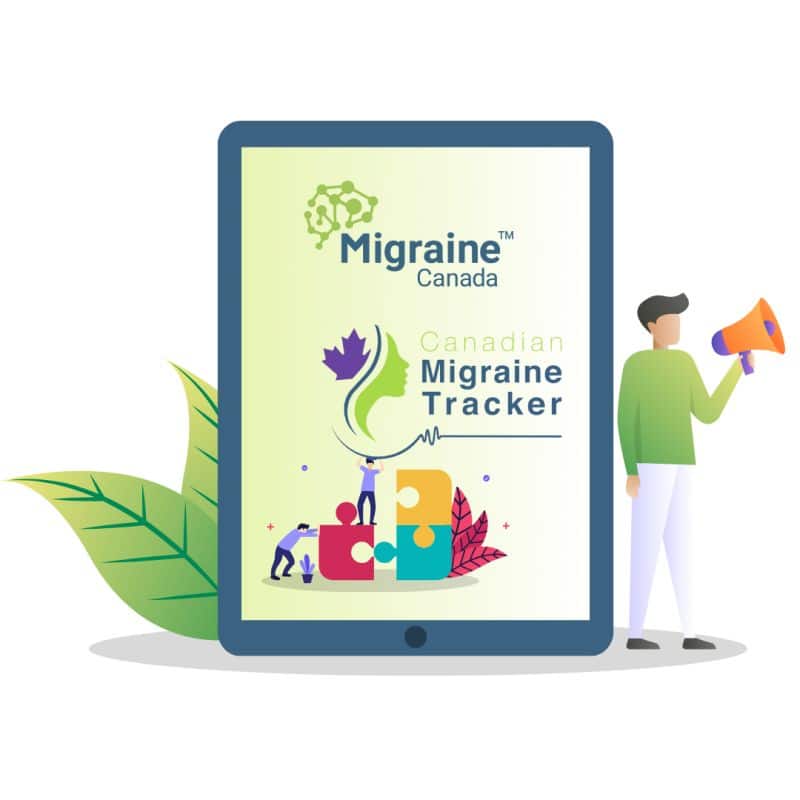This comprehensive Employee Benefits FAQ is a supplementary resource to the Migraine Canada webinar: “Understanding Employee Benefit Plans“, presented by Katrina Di Raddo (BBA, CHRP).
It is designed to help employees understand and navigate group benefits and claim processes, and understand their rights related to workplace health coverage—especially when managing chronic conditions like migraine.
Learn how to maximize your benefits, coordinate coverage from multiple plans, and advocate for improved benefits through human resources or union representatives. This FAQ also covers specific scenarios like disability leave or accommodation and specialized topics like Health Care Spending Accounts (HCSA), Lowest-Cost Alternative drug policies, and government-supported programs such as the Registered Disability Savings Plan (RDSP).
If you’re facing challenges like denied accommodation requests, early return-to-work pressures, or employer changes in migraine treatment coverage, this resource offers practical steps to protect your rights and well-being.
1. General Benefit Information
What are group benefits?
Group benefits are employer-provided insurance and financial benefits, including health, dental, vision, life insurance, disability, and retirement savings plans.
What types of benefits are included in a typical plan?
Health Benefits: Life insurance, accidental death & dismemberment (AD&D), critical illness, disability (STD/LTD), extended health & dental, vision, prescription drugs, sometimes also a Health Care Spending Account (HCSA).
Financial Benefits: Pension plans, registered retirement savings plans (RRSP), tax-free savings plans (TFSA), non-registerd savings plans (NSRP), employee stock options and employee share purchase plans (ESPP).
What’s the difference between a Traditional and Flex Plan?
Traditional plans offer fixed coverage, while Flex Plans let employees choose coverage based on their needs, often with credits to allocate.
Are there waiting periods for benefits?
Yes, often 3–6 months. Always ask if it can be waived or reduced, and review the benefits guide before signing an employment offer.
2. Health Insurance & Claims
Who pays for health insurance benefits?
- Life/ Accidental Death and Dismemberment (AD&D): Typically employer-paid with optional employee-paid top-ups.
- Critical Illness: Usually employee-paid if offered.
- Short-term disability (STD): Typically employer-paid; LTD: typically employee-paid (to receive tax-free benefits if claimed).
What does it mean to coordinate benefits?
If you have more than one benefits plan (e.g., through your spouse), claims go through your own plan first, then through the second. For kids, the parent with the earlier birthdate in the calendar year submits first.
What if I have two plans through two jobs?
Submit to the primary plan (usually the one where you work more hours), then to the second plan.
What is a Health Care Spending Account (HCSA)?
A Health Care Spending Account (HCSA), also known as a Health Spending Account (HSA), is a tax-advantaged benefit provided by employers. It allows employees to use employer-contributed funds to pay for eligible health and dental expenses, including those not covered by a traditional group benefits plan.
What can I use my HCSA for?
You can use your HCSA for qualifying medical and dental expenses as defined by the Canada Revenue Agency (CRA), including premiums paid for health and dental insurance.
How should I submit claims with an HCSA?
Submit your claim to your core group benefits plan first. If any portion of the expense isn’t covered, you can then submit the remaining amount to your HCSA for reimbursement.
3. Prescription & Specialty Medications
What is a Lowest-Cost Alternative process?
The Lowest-Cost Alternative (LCA) process requires you to try a lower-cost medication—typically a generic or less expensive option—before your insurer will approve coverage for a higher-cost drug.
What are specialty drugs?
Specialty drugs are advanced medications (often biologics) used to treat complex or chronic conditions. They usually require pre-authorization and may need to be dispensed at specific pharmacies.
How can I save money on medications and supplies?
You can save by requesting free samples from your healthcare provider, applying for Patient Support Programs, claiming costs on your taxes, and taking advantage of promotions such as Shoppers Drug Mart 20x Points Days.
4. Mental Health Support
What coverage is available for mental health?
Mental health benefits vary by individual employee plans—check amounts, copays, and types of providers covered.
Where can I find mental health providers?
You can find mental health providers through PsychologyToday, your Employee Assistance Program (EAP), and virtual platforms like TELUS Health, Maple, MindBeacon, iCBT, Togetherall and many others.
5. Retirement & Financial Benefits
What’s the difference between a Defined Benefit and Defined Contribution Pension?
A Defined Benefit Pension provides a guaranteed retirement income based on your salary and years of service.
A Defined Contribution Pension depends on the investment performance of the funds contributed by you and your employer—your retirement income is not guaranteed and may vary.
What’s the difference between a waiting and vesting period?
A waiting period is the time you must work before becoming eligible to enroll in a benefits or pension plan (typically 3–6 months).
A vesting period is the time you must remain employed before the employer’s contributions to your pension plan become fully yours (typically 2 years).
Can I withdraw my Group Registered Retirement Savings Plan (RRSP) funds?
Yes, you can withdraw funds from your group RRSP funds under the federal government’s First-Time Home Buyer’s Plan or the Lifelong Learning Plan. Keep in mind that regular withdrawals may be subject to taxes.
What’s the Registered Disability Savings Plan (RDSP) and who qualifies?
The RDSP is a government-registered savings plan designed to help Canadians with disabilities save for long-term financial security. It offers matched government grants and bonds.
To qualify, the beneficiary must be eligible for the Disability Tax Credit (DTC)—which, if approved, can be backdated to increase eligibility for past grants and bonds.
6. Chronic Illness & Migraine-Specific Coverage
What can I do if my employer removes coverage of treatments for migraine?
Reach out to your Human Resources representative and/or insurance provider to discuss your situation. You can request an exception to continue the treatment.
What can I do if my employer doesn’t cover treatments for migraine?
You can request that your employer consider adding migraine treatment coverage at the next annual plan renewal (typically annually for non-union plans or per collective bargaining agreement (CBA) timelines for union plans).
Outside of workplace coverage, your healthcare provider can assist you with:
- accessing free samples to test the medication’s effectiveness;
- applying for patient support programs offered by pharmaceutical companies;
- exploring provincial programs, such as the Exceptional Access Program in Ontario, which may provide coverage for certain medications.).
7. Workplace Accommodations
Is my employer required to accommodate my health condition?
Yes. Under human rights legislation, your employer is required to accommodate your health condition to the point of undue hardship—meaning significant difficulty or expense, or safety risks to you or others.
What accommodations can I request?
Examples of accommodations for migraine include: lighting adjustments, noise reduction, scent-free policies, flexible hours, scheduled breaks, and manager support.
What can I do if my request for accommodations are rejected?
If your accommodation request is denied, you can appeal the decision to your Human Resources representative or third-party adjudicator, if they use one. Support letters from your healthcare provider outlining the medical necessity of the accommodation can assist this process.
If the appeal is denied, you can consider filing a human rights complaint and/or seeking legal advice to explore further options.
8. Disability & Leave
What can I expect if I need to go on short-term long-term disability?
If you need to go on a disability leave, your employer will need to know your last day of work so that they can begin the process. Whether your workplace has disability coverage or if you need to utilize Employment Insurance (EI) Sickness Benefits, there will be forms you and your healthcare provider need to complete.
There is often a delay in pay between your last paycheck and your first disability payment as the paperwork process can take a few weeks. Ensure to keep this in mind for your personal budgeting.
If I’m on disability and the case worker assigned to me is harassing me or disregarding my physician, what should I do?
You can report their conduct to your Human Resources representative as they may not be aware of the case manager’s behaviour and can intervene to address the issue. Another option is speaking with the manager/supervisor of your case manager to discuss your concerns directly. Using both options is a good way to ensure your health and rights are protected.
What can I do if my employer forces me to come back to work before I am medically ready?
This situation is an unfortunate yet common predicament. Sometimes, your employer and/or disability provider may deem you fit-for-work based on their interpretation of your healthcare provider’s information. If you feel you are not ready to return to work:
- You can appeal their decision and ask your healthcare provider for additional or clearer support letters.
- If the insurance continues to deny you, an option is to remain off work and apply for EI Sickness Benefits. A delayed approval or overturn of decision will usually result in retroactive pay.
- If your employer and/or insurer continues to pressure you back without adequate accommodations, you may consider seeking legal advice.
- If you face termination for not returning, a lawyer may be able to assist you in claiming discrimination and/or wrongful dismissal.
Your health and well-being should come first—advocate for the support you need.
How can I ensure a smooth return after medical leave?
To ease your transition back to work:
- Stay in regular contact with your employer during your leave.
- Plan your return in advance, discussing a suitable start date and any necessary accommodations.
- Clarify your tasks and responsibilities to set clear expectations.
- Schedule regular check-ins with your manager or HR to address any concerns.
- Maintain access to support resources to help manage your health and workload.
9. Improving or Advocating for Better Benefits
How can I ask for better benefits?
If you’re non-unionized, speak with your Human Resources representative before the annual benefits plan renewal.
If you’re in a union, talk to your union representative ahead of collective bargaining agreement negotiations.
In both cases, gathering support from coworkers can strengthen your request.



